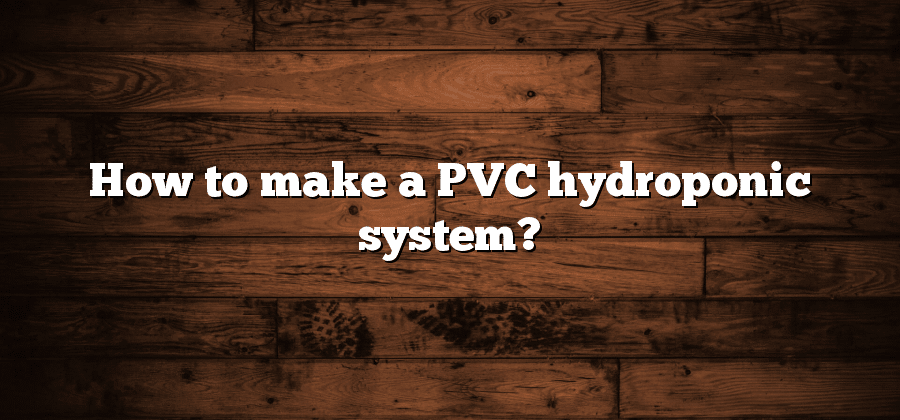Planning the PVC Hydroponic System.
When getting started with a PVC hydroponic system, careful planning is essential. Before diving into the project, take some time to consider your goals and what you hope to achieve with this system. Are you looking to grow a specific type of plant, or do you have a specific amount of space available? Understanding these factors will help you determine the size and design of your hydroponic system.
Next, it’s important to consider the location of your PVC hydroponic system. Take into account factors such as sunlight exposure, temperature, and accessibility. You want to ensure that your plants receive the right amount of light and warmth throughout the day, and that it is easy for you to access and maintain the system. Additionally, keep in mind any potential challenges, such as limited space or restrictions on water usage. By carefully planning your system and considering these factors, you can set yourself up for success in your hydroponic gardening journey.
Selecting the Right PVC Pipes.
When it comes to selecting the right PVC pipes for your hydroponic system, there are a few factors to consider. Firstly, you want to ensure that the diameter of the PVC pipes is sufficient for the amount of water and nutrients that need to flow through them. Typically, pipes with a diameter of 4 inches or more are suitable for most hydroponic setups. Additionally, it is important to choose pipes that are durable and can withstand the weight of the water and plants without bending or cracking.
Another important factor to consider is the type of PVC pipe you choose. There are different types available, such as schedule 40 and schedule 80. Schedule 40 pipes are commonly used for hydroponic systems as they are strong, affordable, and readily available. On the other hand, schedule 80 pipes are thicker, stronger, and more resistant to impact, making them suitable for larger and more complex systems.
Lastly, you should also consider the length of the PVC pipes needed for your hydroponic setup. Measure the height and width of your grow space to determine the appropriate length of pipes required. It is advisable to opt for pipes that are slightly longer than your measurements to allow for flexibility and adjustments during installation. Remember, selecting the right PVC pipes is crucial for the efficiency and effectiveness of your hydroponic system.
Cutting and Measuring the PVC Pipes.
Cutting and measuring the PVC pipes is a critical step in building a successful hydroponic system. Accurate measurements ensure that the pipes fit together seamlessly, creating a sturdy structure to support your plants. Before you begin cutting, it is essential to gather all the necessary tools, including a measuring tape or ruler, a pencil or marker for marking the pipes, and a hacksaw or pipe cutter for making precise cuts.
Start by measuring the required lengths for each pipe based on your system design. Remember to account for any connectors or fittings that may add additional length to the pipes. Mark the measurements clearly on the PVC pipes using your pencil or marker. Double-check the measurements to avoid any errors. When cutting the pipes, be sure to use smooth, steady strokes to ensure clean and straight cuts. It is advisable to wear safety goggles and gloves to protect yourself during this process. Always take your time and exercise caution to achieve accurate measurements and clean cuts for a successful PVC hydroponic system.
Assembling the PVC Hydroponic System.
Assembling the PVC hydroponic system is a crucial step towards setting up your own indoor garden. To ensure a successful setup, it is important to follow a systematic approach and pay attention to details. Begin by laying out all the required components and materials in an organized manner. This will allow you to easily access the necessary parts and avoid any confusion during the assembly process.
Next, start by connecting the PVC pipes together using the appropriate fittings. Make sure to securely fasten the pipes to prevent any leaks or weak joints. It is also essential to measure and cut the pipes accurately, ensuring they fit together with precision. Utilizing a hacksaw or PVC pipe cutter will help you achieve clean and precise cuts. Once all the pipes are connected and cut to the desired length, move on to adding any additional components such as valves, connectors, or water distribution tubes. Taking time to properly assemble the PVC hydroponic system will lay a solid foundation for the success of your hydroponic garden.
Choosing the Suitable Containers for Hydroponic Plants.
When it comes to choosing the suitable containers for hydroponic plants, there are a few important factors to consider. Firstly, it is crucial to select containers that are specifically designed for hydroponic systems. These containers are typically made from materials such as plastic or fabric, which are durable, lightweight, and non-toxic to the plants. Additionally, opt for containers that have good drainage capabilities to prevent waterlogging and root rot. Ensuring proper drainage will help maintain the optimal moisture level for the plants’ roots, promoting healthy growth and preventing the risk of disease.
Another factor to keep in mind is the size of the containers. The size of the containers will depend on the type of plants you are growing and the available space in your hydroponic system. It is essential to choose containers that are appropriate for the size and growth habits of your plants. Containers that are too small can restrict root development and hinder the plants’ overall growth, while excessively large containers can lead to inefficient water and nutrient distribution. Consider the specific requirements of your plants and select containers that provide ample space for root expansion while maximizing the use of your hydroponic system’s available space.






